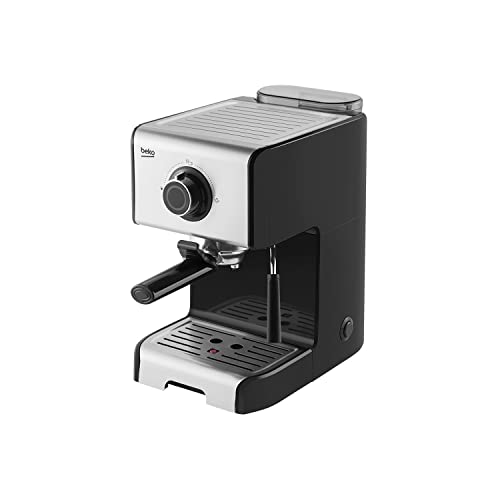How to Maintain Espresso Machines
Espresso drinks can be beneficial to businesses like hair salons, doctor' offices, and car dealerships. These gourmet drinks can increase your customers' patience when they wait for service and also improve the ambience inside your establishment.
A Good Housekeeping 2022 Espresso Machine winner, this cutting-edge machine uses smart dosing technology to weigh and dispense the ideal amount of ground coffee for each shot. It also includes a milk frothing wand that was a success in our tests for producing steaming milk.
The Basics
Espresso machines are a great accessory for any office or home. They can be used for many different drinks, like lattes or cappuccinos. They work by pushing hot coffee into the ground at high pressure. This creates an intense shot of coffee that is very delicious. It also has a significant level of caffeine that can be a powerful stimulant.
These types of machines come in a variety of sizes from compact models that are ideal for homes to larger ones designed for commercial use. They are available in semi-automatic and manual versions. Semi-automatic machines are equipped with a built in pump that controls the flow and pressure of water. Manual machines require you to control this manually. Certain semi-automatic models feature grinders, while others do not. The type of machine you choose will be determined by your budget and personal preferences.
Manual espresso machines work by allowing the user to use a handle to push water through grounds that have been placed in a filter basket. This type of machine, also referred to as a caffettiera or macchinetta is the most well-known form of espresso maker. It features an inner chamber that holds the water and top chamber with a metal filter. When heated, steam is forced through the coffee grounds before being pushed into the top of the machine. There, the espresso is ready to serve.
Varieties
Depending on your preferences, you can choose among a variety of espresso machines. There are semi-automatic, manual, and fully automatic espresso machines. Each one has its own way of making an espresso shot and a variety of beverages, such as cappuccinos and lattes.
The first machines weren't fully automated. best small espresso machine required the user to operate the lever to generate the pressure necessary to pull one shot. Although these machines still exist, they are not as common because they require lots of effort and are often exhausting to operate. Modern espresso machines use a variety of mechanisms to generate pressure such as push, screw and see-saw designs. This allows the user to manage pre-infusion and water volume more precisely than the lever machine.
Pump-driven espresso machines are similar to stovetop mokapots however they utilize an electric pump to press the coffee grounds instead of steam. The boiler heats water until boiling point, and a pump then pushes it through a group head. They are the most well-known type of espresso machines and are generally less expensive than other types.
Semi-automatic espresso machine combine the best aspects of both pumps-driven and manual espresso machines. They let the user grind and tamp the beans but a motor controls the pressure to ensure consistency during extraction. They also have a separate chamber that heats and froths milk, and some have a built-in grinder.
Functions
Commercial espresso machines can make numerous coffees and espressos at the push of the button. They use pre-packaged espresso pods that are precisely dosed and packed to make an espresso cup or coffee. These compact machines are free of the requirement for grinders, dosing or tamping, making them an ideal choice for busy offices. However, since they lack steam functions, you'll require an additional milk frother in order to make lattes and cappuccinos.
In the 19th century, many cafes in Europe depended on steam machines to reduce brewing time and boost production. But these early machines were heated by an open flame, resulting in inconsistent temperature and pressure. Angelo Moriondo, an Italian inventor from Turin is credited with inventing the first machine to brew coffee without steam.
The most commonly used type is the pump-driven espresso machine. These machines utilize portsafilters to hold the ground espresso beans. When the valve is turned to the espresso position it extracts the espresso by water under 15 atmospheres of pressure in the heating vessel. After the brew cycle, the portafilter is taken out and emptied to be cleaned.
Automated espresso machines are semi-automatic systems by regulating the extraction time based on internal or volumetric timers. They also eliminate the barista’s ability to tamp or grind coffee, which may affect the quality of the final product.
Maintenance
Espresso machines may not be the most glamorous equipment in a cafe, but they're extremely important. The way you maintain the espresso machine will impact the quality and taste of your drinks.
Clean espresso machines ensure that the flavor of your coffee won't be compromised and your customers will have a wonderful experience. Maintaining a regular schedule of cleanings can prolong the life of your espresso machine.

Use a damp cloth and clean the baskets and portafilters once every shift to remove any oil or residue. Backflush the gasket between the portafilter head as well as the grouphead by inserting the nylon brush and moving it to eliminate any build-up. Rinse the gasket, and then repeat the process until the water is clear.
Once a week, or as needed mix espresso machine cleaner into a container of water according to the manufacturer's instructions. Then soak the portafilters, gratings, and baskets overnight in the cleaning solution. If your espresso machine is equipped with a steam wand or screen, take them out of the set using an screwdriver. Separately soak them in the cleaning solution.
